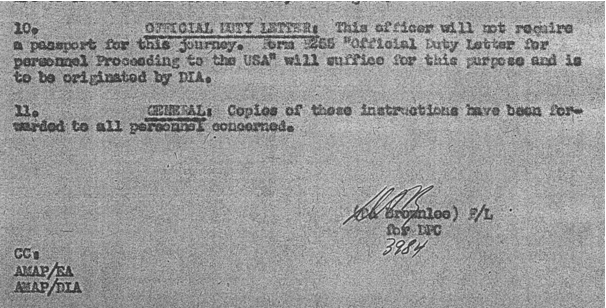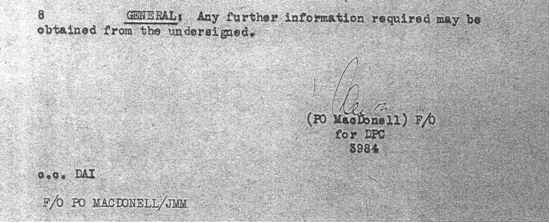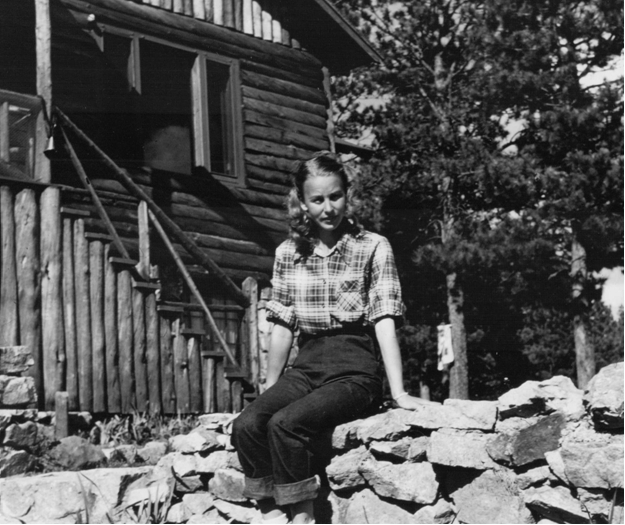
The Life and Times of Hubert Brooks M.C. C.D.
A Canadian Hero

 |
|
 |
On 10–April–1948 the R.C.A.F Flyers were disbanded. My "special leave" from regular duty expired on Sunday 25–April–1948. The following day I resumed my duties back at Air Force Headquarters Ottawa.
The Directorate of Intelligence that I was then associated with was still located in "A" Building of the Headquarters complex.
The focus now was resuming my training in the Intelligence field. The R.C.A.F. arranged a course for me to take at THE PENTAGON in Washington DC. I left for Washington 18–Aug–1948.
From 19–Aug–1948 to 13–Nov–1948 I was posted to CIS Washington (Seep). I worked out of (R.C.A.F.) F/L Wattie's office in room 3E180 of The Pentagon when I was not attending courses.

|

|
My Strategic Intelligence School course was cryptically called "course 8" and was put on by the
Intelligence Division General Staff. It lasted from 23–Aug–1948 to 12–Nov–1948.
I passed!
Bea and I really liked Washington D.C. during out time there. It was one of our favorite postings. Bea was particularly impressed with the blooming of the cherry blossoms.
I returned from my course on 14–Nov–1948. I would remain in Ottawa as essentially a staff officer doing ‘routine analysis and follow–up’ with the Directorate of Air Intelligence until 5–Jan–1954.
While in Ottawa I started flying again out of R.C.A.F. Station Rockcliffe. I assumed the navigator role. From 1949 until the end of 1953 our aircraft progressed from Beechcraft, to B–25 then C–45, to C–47 aircraft. We would go to various locations across Canada; Toronto, Montreal, Edmonton, Winnipeg and so on.
Flying out of R.C.A.F. Rockcliffe during this period I�d accumulated some 320+ hours. I was very pleased with this.
Bea and I were living at apt 201, 474 Wilbrod, Ottawa. My son Ralf was born in Ottawa during this posting.
A number of other ‘events’ of note took place during this time period.
Even though I had been promoted to Flying Officer October 1947 a ‘minor issue’ remained that I had not formally taken the Flying Officer exams! I did this towards the end of 1949 and passed.
On 1–Oct–1949 the Air Force altered my status from "short (5 year) service commission" to "permanent commission". I was very happy with this. I still retained the rank of Flying Officer.
I was promoted to Flight Lieutenant effective 1–January–1950.
The Air Force decided in early 1950 that they wanted me to attend the SAC Survivor School Advanced Training Course held at Camp Carson (near Colorado Springs) Colorado.
The R.C.A.F. had volunteered my presence to provide the instructors of this newly instituted course, feedback on course relevancy and opportunities for improvement.

|

|
I attended the advanced Survival Training course between 21–Aug–1950 and 3–Sept–1950. By the way, I passed and was also able to pass along some suggestions to the training staff.
Some background as to objectives of the aircrew survival training course are as follows:
These courses had been initiated by Commander in Chief of Strategic Air Command (SAC), General Curtis E. LeMay.
Convinced of a critical need for escape and evasion program for SAC LeMay believed that with the proper training in environmental and situational survival, the Air Force could decrease aircrew member losses during conflict. He was especially interested in the Resistance Training – based on the negative experiences of US pilots and other GI's captured in Korea.
General LeMay directed the establishment of a mountainous terrain survival school at Camp Carson, Colorado on 16 Dec 49. The area around Camp Carson had been chosen because the surrounding terrain resembled certain areas of military interest in the Soviet Union.
Training began on 1 April 1950. Initially, the school was operated by the 3904th Training Squadron of Strategic Air Command. The faculty and staff were a cadre of survival specialists gathered from US Air Force, Army, and reserve sources.
As mentioned the course provided survival, evasion, resistance, and escape training. Instruction concentrated on the principles, techniques, and skills necessary to survive in any environment – but in particular mountainous environments– and return home. Training was provided in post ejection procedures and parachute landing falls, various life support of equipment procedures, and survival medicine. Additional training included shelter construction, food scavenging and preparation, day and night land navigation techniques, evasion travel and camouflage techniques, ground–to–air signals, and aircraft vectoring procedures. There was classroom training on the physical and psychological stresses of survival.
While I was at the course Bea went to a "dude ranch" just outside of Colorado Springs. She had a great time and I was able to join her for a few days just after the course ended.



As with the Flying Officer exams, the Air Force had been a bit remiss in not having me take the formal Flight Lieutenant Qualifying exams before making the promotion.
I took these exams early 1954.
I failed!
This was the first failure of note I had had in Air Force. I was not pleased. I just didn't get the testing regime and had problems formulating essay type responses to hypothetical questions. My grade 10 education was coming back to haunt me. I was too involved now in my career to go back to school. I would simply have to learn to swim on my own with the Kingston / Royal Roads and similarly educated colleagues who had been smart enough to complete their education.
I would take the exam again and pass it this time.
Moving into late 1953 the R.C.A.F. set out a long range plan for utilizing my Intelligence training.
It was a fairly detailed defined career path.
I was to be sent out to maritime patrol training at Summerside, PEI followed by embedded participation in a Maritime Patrol base at Comox, Vancouver Island, I would then be sent to my final target destination of West Coast HQ for the Navy at Esquimalt Vancouver Island. There I would be the R.C.A.F. liaison officer funneling aerial reconnaissance intelligence and associated analysis of foreign shipping (especially military) off the west coast to the navy. My last day at R.C.A.F. HQ in Ottawa was 5–January–1954.
| PREVIOUS PAGE | GO TO TOP OF PAGE FOR INTER- and INTRA- CHAPTER NAVIGATION MENUS |
NEXT PAGE |
The Life and Times of Hubert Brooks M.C. C.D.